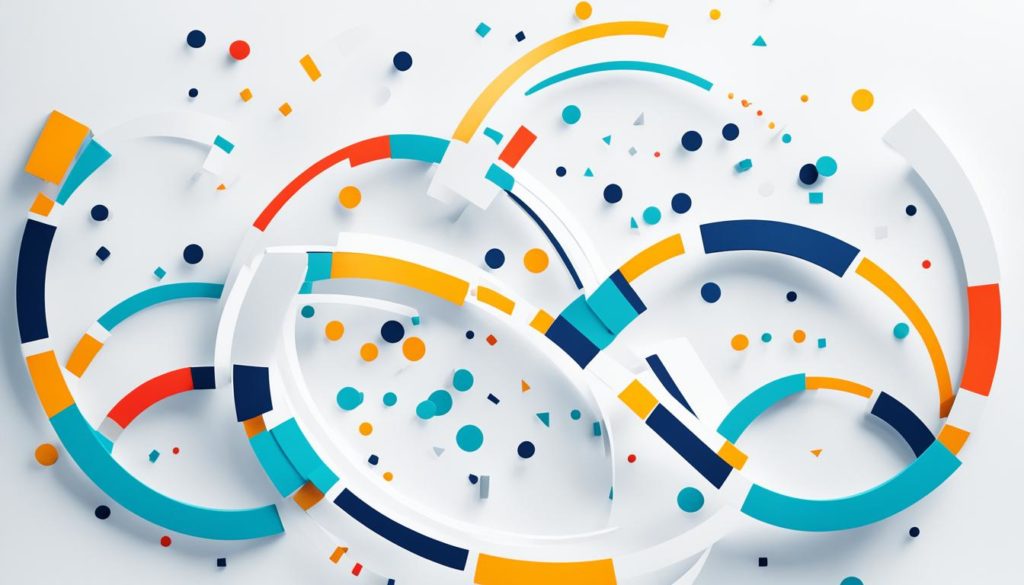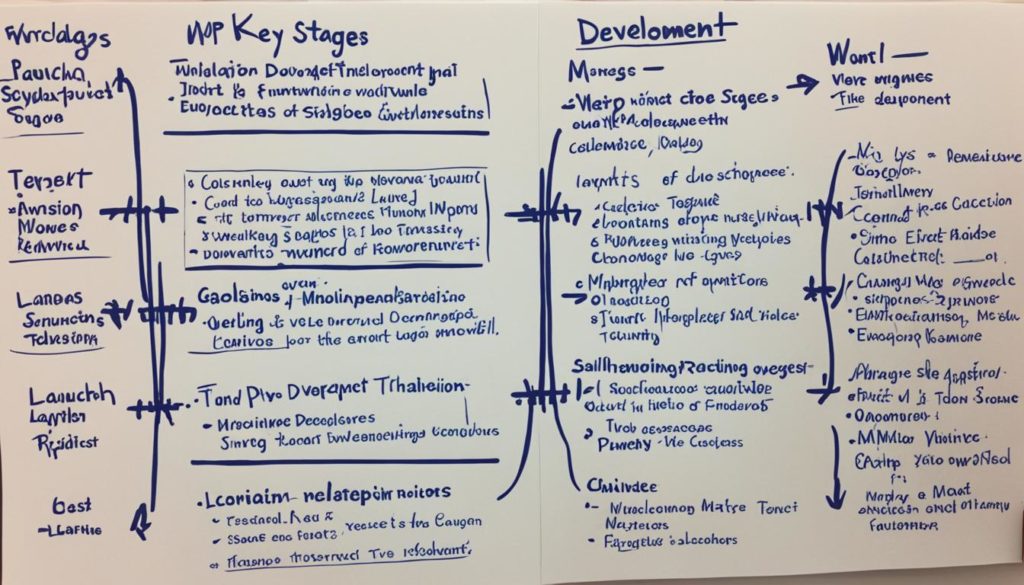
Did you know that companies using UX design thinking see a huge 228% increase in their ROI? This shows how crucial this method is in today’s product development. Digital product innovation is key for brands wanting to connect deeply with their users.
UX design thinking is all about empathy, coming up with new ideas, and making changes based on feedback. It helps product managers create products that really speak to users. By understanding what users need and improving based on their feedback, we make sure our products hit the mark.
At the heart of UX design thinking, empathy and constant improvement are key. This mindset is essential for creating solutions that really make a difference. As we work on product development, using user feedback is a key principle that boosts innovation and makes our products better.
Key Takeaways
- Companies using UX design thinking see a 228% ROI increase.
- UX design thinking is crucial for digital product innovation.
- Empathy and iterative processes are key parts of this approach.
- Understanding and adapting to user needs is vital for great products.
- User feedback is essential for ongoing improvement in product development.
Introduction to UX Design Thinking
UX design thinking is key in product development. It starts with understanding user experiences and a focus on people. This approach helps make products that really connect with users.
Understanding the Basic Concepts
UX design thinking is all about making a deep impact on users. It’s about knowing their challenges, wants, and goals. By putting ourselves in their shoes, designers can make solutions that work well and engage users.
The Importance of UX in Today’s Digital Landscape
UX design is vital in today’s fast-changing digital world. It shapes how we use products. By focusing on people, we make sure digital tools are easy to use and accessible. Tools like interviews and research help guide the product’s direction.
Design empathy lets us build digital products that are not just useful but also fun to use. As shown in this guide, UX design is a journey of ongoing improvement. It ensures we always meet and go beyond what users expect.
The Human-Centered Design Approach
At the heart of human-centered design is empathy. It lets us see things from the user’s point of view. We use various research methods to deeply understand users’ lives.
Empathizing with Users
Empathy means we get to know users’ needs, what drives them, and their problems. Interviews and watching how users behave are key ways to do this. They give us direct info on how users use products, their struggles, and what they really want.
This approach makes sure our solutions really make a difference in users’ lives. It’s not just about fixing technical issues. It’s about solving human needs effectively.
Adaptive User Research Techniques
Adaptive research is key to improving product ideas. It includes methods like brainstorming and prototyping to explore many solutions. This way, we make sure our designs fit the diverse needs of users.
This method keeps us testing and improving our designs with user feedback. The cycle of brainstorming and prototyping leads to solutions that really connect with users.

Implementing UX Design Thinking in Product Development
UX design thinking is key to making products better. It puts the user at the center of every step. This iterative design methodology leads to ongoing improvement and new ideas.
Stages of the UX Design Thinking Process
The design thinking process stages are crucial for making products that focus on users. These stages include:
- Empathize: Getting to know what users need and their problems through research and interviews.
- Define: Using the info gathered to clearly state the problem.
- Ideate: Coming up with many ideas and possible solutions.
- Prototype: Making simple models of the top ideas.
- Test: Testing with users to get feedback and improve the product step by step.
These steps are not just one after the other. They go back and forth, making sure the product gets better with user feedback.
Case Studies: Successful Implementations
Many successful UX design case studies show how well this method works. Companies like Apple and Google have changed their products with design thinking. They keep making prototypes and testing them to stay ahead of what users want and market trends.
Here’s a look at some key metrics showing how design thinking helps products succeed:
| Company | Product | Design Thinking Initiative | Outcome |
|---|---|---|---|
| Apple | iPhone | Continuous User Feedback Loops | High User Satisfaction, Market Leadership |
| Google Maps | Rapid Prototyping & Testing | Enhanced User Experience, Wide Adoption | |
| IBM | Watson | Empathize & Define Stages | Tailored Solutions, Increased Efficiency |
These examples show how design thinking leads to products that go beyond what users expect.
Prototyping and Iteration: A Continuous Improvement Cycle
Modern UX design thinking is all about a continuous improvement cycle. We use the iterative design methodology to make sure our products keep getting better. This way, they meet what users need and like.
Rapid prototyping is a big part of this. It lets us test ideas in real life. This closes the gap between what we plan and what users actually experience.
Building Rapid Prototypes
Creating rapid prototypes is key. It lets us try out new features and check if they’re easy to use. By quickly turning ideas into something we can test, we spot problems early. Then, we can fix them before we go too far.
Iterative Testing and Feedback
After making prototypes, we start testing and getting feedback. This way, we learn what users think. By using this feedback, we can make small changes to improve the product. These changes match what users expect.
This table shows how our approach is better:
| Aspect | Traditional Method | Iterative Approach |
|---|---|---|
| Development Speed | Slower, due to prolonged planning phases | Faster, with early and ongoing testing |
| User Satisfaction | Often assessed late in the process | Continuously assessed during development |
| Flexibility | Rigid, with potential for extensive reworks | Flexible, allowing for ongoing adjustments |
| Risk Management | Higher, with risk of major changes | Lower, with iterative minimization of risks |
By always iterating and listening to feedback, we make sure our product stays relevant. This keeps user satisfaction high and drives ongoing improvement.
Fostering a Culture of Creativity and Innovation
Starting innovation in our organization means making a space that helps with creative problem-solving. We do this by having brainstorming sessions where everyone’s ideas count. This way, we get past old ways of thinking and give everyone a voice.
Encouraging people to take risks is also key to innovation. We know that sometimes we’ll fail, but that’s how we learn and grow. By making a safe space where everyone feels heard and trusted, we let new ideas come to life.
Also, innovation is a team effort. Collaborative brainstorming brings together our unique ideas. This leads to new solutions and boosts our creative problem-solving skills.
| Strategy | Benefit |
|---|---|
| Collaborative Brainstorming | Diverse ideas from multiple perspectives |
| Encouraging Risk-Taking | Greater innovation through experimentation |
| Valuing Team Input | Increased morale and trust leading to creativity |
| Supportive Environment | Safe space for idea generation and growth |
We put these strategies at the heart of our culture. This brings in new ideas that move our products forward. By using UX design thinking, we make a place where creativity and innovation lead every project to success.
Conclusion
As we conclude our look at UX design thinking, it’s clear that UX methodology is more than a choice. It’s a promise to make digital products that really connect with users. We’ve seen how focusing on people, empathy, and testing can change how we make products.
Adding these ideas to our work makes the user experience better. It makes sure our products do more than just work. They meet and beat what users expect, building loyalty and making us stand out online. Research, making prototypes, and getting feedback are key to staying innovative and creative.
UX methodology means putting the user at the heart of our work. It’s not just a trend; it’s essential for making products that matter and please users. By following these steps, we help our products succeed and stay current in the fast-changing digital world.
FAQ
What is UX design thinking and why is it important?
UX design thinking focuses on understanding what users really need and want. It uses empathy, idea generation, and a cycle of design to make products that users love. This approach is key to creating products that work well and connect with users.
How does UX design thinking differ from traditional design approaches?
Traditional design focuses on what the product should do without much thought for the user’s experience. UX design thinking puts the user at the center. It uses deep research and empathy to find out what users really need. This leads to designs that are more innovative and focused on the user.
What are the main stages of the UX design thinking process?
The UX design thinking process has several stages. First, we get to know the users by empathizing with them. Then, we define the problem. Next, we come up with ideas, make prototypes, test them, and keep improving based on feedback.
What role does empathy play in UX design thinking?
Empathy is crucial in UX design thinking. It means understanding and feeling what users feel to make solutions that really help them. Techniques like interviews and watching user behavior give us insights into what users go through, helping us make better design choices.
Can you give an example of a successful implementation of UX design thinking?
Airbnb is a great example. They used UX design thinking to understand what hosts and guests needed. This led to a platform that made users happier and more engaged, helping Airbnb grow fast and succeed.
What are some common user research techniques used in UX design thinking?
Techniques like user interviews, surveys, focus groups, and usability testing are common. They help us learn about what users like, what they struggle with, and what they want. This information shapes our designs.
How does prototyping contribute to the UX design thinking process?
Prototyping is key in UX design thinking. It lets designers quickly turn ideas into something real. This way, we can test with users, get feedback, and make changes. Prototyping and testing together help us make products that really meet user needs.
What is the significance of an iterative design methodology in UX design thinking?
An iterative design approach is crucial. It lets us keep improving based on what users say. By designing, prototyping, and testing over and over, we make sure our product meets user expectations. This leads to a product that users love.
How can organizations foster a culture of creativity and innovation through UX design thinking?
To encourage creativity and innovation, organizations should support teamwork, encourage trying new things, and value different ideas. UX design thinking means creating a place where everyone feels safe to share and where creativity is valued.
What are the benefits of embracing UX design thinking for product managers?
UX design thinking helps product managers make sure their products focus on users. It leads to continuous improvement and innovation, making products that users love. This approach is key to standing out in a crowded market.
Future App Studios is an award-winning software development & outsourcing company. Our team of experts is ready to craft the solution your company needs.









